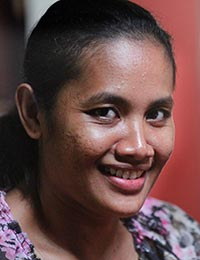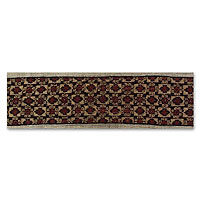- Home
- >
- Ni Luh Suryati
Ni Luh Suryati
This fabric, made from a process found only in Tenganan and two other locales on Earth, supposedly has the power to ward off evil... A single piece can take up to five years to complete.
"My name is Ni Luh Suryati and I was born in Bali on April 4, 1980. I learned the intricate process of double ikat... weaving and dyeing from Wayan Bawa, my own mother. In creating the double ikat cloth, I am inspired by Balinese tradition, especially Tenganan tradition. I use natural dyes like sunti and indigo, and as well as artificial ones for the coloring."
A slice of traditional Balinese life can be had in the original Balinese settlement of Tenganan. In this stronghold of Balinese native traditions (aboriginal, pre-Hindu inhabitants), life is slower, more traditional. People are quieter, friendlier, more dignified.
Today, only 180 families, about 400 people live in Tenganan. With very few young people marrying outside the village, there's practically zero population growth. The graceful Balinese carry a sense of their Hindu sacredness into every step of their daily life. Every endeavor is approached with reverence; dancers, artists, and craftsmen create as if their skill flowed through them directly from God. Religion is life, craft, and art. None exists without the other, and nowhere can this be experienced more clearly than in the many small villages that dot the heart of Bali. Each village has a temple, and religious festivals and rituals are held somewhere on Bali almost continuously.
The women of Tenganan, through an intricate process of double ikat weaving and dyeing, create the famous "flaming" cloth known as kamben geringsing (sarong). This fabric, made from a process found only in Tenganan and two other locales on Earth, supposedly has the power to ward off evil.
Ikat means "to knot" in Indonesian and Malay, and it is a time-consuming process known only to a handful of weavers around the world. Hand-spun cotton is initially dyed an eggshell-yellow hue using the oil of the kemiri nut, before the weaver determines which sections of the thread are to be dyed with what colors. She binds bunches of the fabric together with raffia, creating a tight knot resistant to the dyes in which the piece is to be placed. This process is carried out for each successive color, as the artisan uses natural extracts, such as indigo for the blue tones and root barks for the spectacular vermilion hue. A simple handloom is employed to execute the weave.
The finest pieces of the fabric are worn by the people of Tenganan in their many ceremonies. A single piece can take up to five years to complete.
A slice of traditional Balinese life can be had in the original Balinese settlement of Tenganan. In this stronghold of Balinese native traditions (aboriginal, pre-Hindu inhabitants), life is slower, more traditional. People are quieter, friendlier, more dignified.
Today, only 180 families, about 400 people live in Tenganan. With very few young people marrying outside the village, there's practically zero population growth. The graceful Balinese carry a sense of their Hindu sacredness into every step of their daily life. Every endeavor is approached with reverence; dancers, artists, and craftsmen create as if their skill flowed through them directly from God. Religion is life, craft, and art. None exists without the other, and nowhere can this be experienced more clearly than in the many small villages that dot the heart of Bali. Each village has a temple, and religious festivals and rituals are held somewhere on Bali almost continuously.
The women of Tenganan, through an intricate process of double ikat weaving and dyeing, create the famous "flaming" cloth known as kamben geringsing (sarong). This fabric, made from a process found only in Tenganan and two other locales on Earth, supposedly has the power to ward off evil.
Ikat means "to knot" in Indonesian and Malay, and it is a time-consuming process known only to a handful of weavers around the world. Hand-spun cotton is initially dyed an eggshell-yellow hue using the oil of the kemiri nut, before the weaver determines which sections of the thread are to be dyed with what colors. She binds bunches of the fabric together with raffia, creating a tight knot resistant to the dyes in which the piece is to be placed. This process is carried out for each successive color, as the artisan uses natural extracts, such as indigo for the blue tones and root barks for the spectacular vermilion hue. A simple handloom is employed to execute the weave.
The finest pieces of the fabric are worn by the people of Tenganan in their many ceremonies. A single piece can take up to five years to complete.

